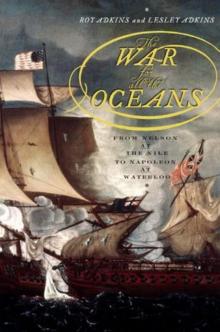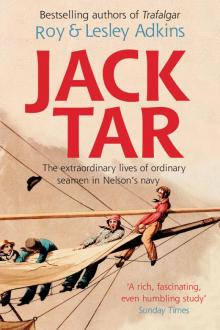- Home
- Roy Adkins
The War for All the Oceans
The War for All the Oceans Read online
Table of Contents
Title Page
Copyright Page
Dedication
LIST OF ILLUSTRATIONS
Acknowledgements
PREFACE
ONE - GATEWAY TO INDIA
TWO - BATTLE OF THE NILE
THREE - SIEGE OF ACRE
FOUR - FROM NAPLES TO COPENHAGEN
FIVE - WAR AND PEACE
SIX - HOT PRESS
SEVEN - INVASION FLEET
EIGHT - TURNING POINT
NINE - IN EVERY SEA
TEN - CONFLICT AND COMMERCE
ELEVEN - THE SEA WOLF
TWELVE - BY LAND AND SEA
THIRTEEN - THE GRAND EXPEDITION
FOURTEEN - DISASTER
FIFTEEN - PRISONERS AND PRIVATEERS
SIXTEEN - THE HAND OF PROVIDENCE
SEVENTEEN - TRIUMPH AND TRAGEDY
EIGHTEEN - THE GREAT MISTAKE
NINETEEN - UP THE CHESAPEAKE
TWENTY - STAR-SPANGLED BANNER
TWENTY-ONE - SWANSONG
TWENTY-TWO - THE TURN OF FORTUNE’S WHEEL
NOTES
SELECTED READING
BIBLIOGRAPHY
INDEX
PENGUIN BOOKS THE WAR FOR ALL THE OCEANS
Roy and Lesley Adkins are both historians and archaeologists and Fellows of the Society of Antiquaries of London. Between the two of them, they’ve written Nelson’s Trafalgar: The Battle That Changed the World, The Keys of Egypt: The Race to Crack the Hieroglyph Code, and Empires of the Plain: Henry Rawlinson and the Lost Languages of Babylon.
To find out more, please visit www.adkinshistory.com.
Praise for The War for All the Oceans
“Engrossing . . . The Adkinses display such superb technological knowledge of their subject. . . . A superior work of maritime history that both scholars and general readers should enjoy.” —Booklist
“In this vivid history, the husband-and-wife historians . . . illuminate aspects of life at war and on the home fronts, quoting from diaries, letters, and journals. Sumptuous storytelling re-creates the first worldwide war. . . . This real-life action will delight fans of fictional heroes from the same wars—Horatio Hornblower (C. S. Forester) and Richard Sharpe (Bernard Cornwell).”
—Kirkus Reviews
“Meticulously researched—drawing on extensive and intimate eyewitness accounts from contemporary journals, letters and memoirs—this lively narrative will delight students and fans of nautical history.” —Publishers Weekly
“A rollicking, patriotic account of the Napoleonic wars that will go down well with Master and Commander fans.” —The Telegraph
“Lesley and Roy Adkins deserve our gratitude for allowing some of these ‘sturdy souls’ to speak again so vividly.” —The Observer (London)
“Very readable and lively. There are tales of derring-do alongside portraits of characters such as the brilliant, eccentric naval commander Sir Sidney Smith.”
—Financial Times
“One of the many strengths of this book is the way that it is not just the captains and commanders who speak to us through the numerous firsthand accounts that the authors weave into their narrative, but also the seamen and the prostitutes— thus conveying a sense of the Great War’s human dimensions, as well as the official history, the black humor as well as the bravery, the devilry as well as the sheer dogged determination to survive and win this hellish war.” —Salon
"The stories in this book evoke the romance of seafaring in the age of wooden ships and muzzle-loading guns. All the original firsthand texts are well-selected and written with verve and clarity. This is fine entertainment.” —Naval History
“A fascinating study . . . In this action-packed and highly readable book, the narrative rattles along like a C. S. Forester or Patrick O’Brian novel, with a wealth of detail about naval life . . . making this one of the most authoritative but accessible studies of Nelson’s navy available.” —The Geographical Journal
“A first-class book, wide in scope and gripping in detail. From diseases to prostitutes to military action, Adkins brings knowledge and power to the subject. It would be difficult to find a more creative book on the British navy during its most tumultuous period.” —Oxford Times
“Full of gripping eyewitness accounts of what happened . . . We won’t spoil the ending but Nelson plays a blinder.” —Motor Boat & Yachting
“Hazardous but often abortive operations, fireships and rocket batteries, primitive torpedoes . . . such daredevilry comes alive—a drama of blazing ships and broadsides and the awesome power of the elements, which even the finest of the many modern fiction interpreters of the era could hardly improve on.”
—The Sunday Times
"Roy and Lesley Adkins have written a marvelous narrative history....There is no question that sea power contributed mightily to Napoleon’s defeat, and this fine book drives home that point colorfully.” —History Book Club
“Another masterly work from the Adkinses . . . a breathtaking journey through one of the most glorious periods.” —The Herald Express
PENGUIN BOOKS
Published by the Penguin Group
Penguin Group (USA) Inc., 375 Hudson Street, New York, New York 10014, U.S.A.
Penguin Group (Canada), 90 Eglinton Avenue East, Suite 700, Toronto,
Ontario, Canada M4P 2Y3 (a division of Pearson Penguin Canada Inc.)
Penguin Books Ltd, 80 Strand, London WC2R 0RL, England
Penguin Ireland, 25 St Stephen’s Green, Dublin 2, Ireland (a division of Penguin Books Ltd)
Penguin Group (Australia), 250 Camberwell Road, Camberwell,
Victoria 3124, Australia (a division of Pearson Australia Group Pty Ltd)
Penguin Books India Pvt Ltd, 11 Community Centre,
Panchsheel Park, New Delhi - 110 017, India
Penguin Group (NZ), 67 Apollo Drive, Rosedale, North Shore 0632,
New Zealand (a division of Pearson New Zealand Ltd)
Penguin Books (South Africa) (Pty) Ltd, 24 Sturdee Avenue,
Rosebank, Johannesburg 2196, South Africa
Penguin Books Ltd, Registered Offices:
80 Strand, London WC2R 0RL, England
First published in Great Britain by Little, Brown Book Group 2006
First published in the United States of America by Viking Penguin,
a member of Penguin Group (USA) Inc. 2007
Published in Penguin Books 2008
Copyright © Roy Adkins and Lesley Adkins, 2006
All rights reserved
Maps on pages xvii, xviii, xix, 289, and 413 illustrated by John Gilkes
eISBN : 978-0-143-11392-8
1. Second Coalition, War of the, 1798-1801—Naval operations. 2. Napoleonic Wars, 1800-
1815—Naval operations. 3. Great Britain. Royal Navy—History—19th century. 4. France.
Marine—History—19th century. I. Adkins, Lesley. II. Title.
DC153.A245 2007
940.2’745—dc22 2006101017
The scanning, uploading and distribution of this book via the Internet or via any other means without the permission of the publisher is illegal and punishable by law. Please purchase only authorized electronic editions, and do not participate in or encourage electronic piracy of copyrighted materials. Your support of the authors’ rights is appreciated.
http://us.penguingroup.com
To Mick Sharp and Jean Williamson,
photographers and friends
par excellence
LIST OF ILLUSTRATIONS
The Temple prison in Paris (Naval Chronicle 34, 1815)
Sir Sidney Smith (Author collection)
A plaque marking the burial of the many drowned in the wrec
k of the Invincible (Lesley and Roy Adkins)
A seaman being taken by the press-gang (The Log Book; or, Nautical Miscellany, 1830)
The north-west side of Diamond Rock (United Service Journal, 1833)
The north-east side of Diamond Rock (United Service Journal, 1833)
Action between a French squadron and Vincejo (Naval Chronicle 34, 1815)
The Dardanelles squadron under the command of Sir John Duckworth (Author collection)
A cannon from the frigate Anson (Lesley and Roy Adkins)
Bitche prison (Langton, 1836)
The ‘Raie-de-Chat’ near Blankenberge (Boys, 1864)
The memorial at Norman Cross (Lesley and Roy Adkins)
View from Batz up the River Scheldt towards Antwerp (Bourchier, 1873)
The United States defending the Macedonian ( J Frost, The Book of the Navy; comprising a general history of the American Marine, 1843)
The attack on Captain Philip Broke of the Shannon (Brighton, 1866)
Chesapeake Mill (Brighton, 1866)
The obelisk monument at Little Dunham (Lesley and Roy Adkins)
The White House (Lossing, 1868)
Plan of Dartmoor prison (Lossing, 1868)
Napoleon on board the Bellerophon (Las Cases, 1835)
John Wesley Wright (Naval Chronicle 34, 1815)
John Nicol (Nicol, 1822)
Captain Thomas Cochrane (Author collection)
Captain Charles Lydiard (Naval Chronicle 19, 1808)
Sir Samuel Hood (Naval Chronicle 17, 1807)
Donat Henchy O’Brien (O’Brien, 1839)
Captain Sir William Hoste (Hoste, 1887)
Sir Home Riggs Popham (Naval Chronicle 16, 1806)
Edward Codrington (Bourchier, 1873)
Stephen Decatur (Author collection)
James Lawrence (Lossing, 1868)
William Henry Allen (Lossing, 1868)
ACKNOWLEDGEMENTS
We are very pleased to acknowledge the help of many people and organisations during the writing of this book. The staff of numerous libraries and archives gave us invaluable assistance, most notably the Caird Library and the Manuscripts Department at the National Maritime Museum, Greenwich; the British Library; the National Archives at Kew; Colindale Newspaper Library; The London Library; University of Bristol Arts and Social Sciences Library; Exeter University Library; Exeter Cathedral Library; Devon Library and Information Services (particularly Exeter Central Library and St Thomas Library, most notably Jill Hughes, Lisa Podbury, Judith Prescott, Katie Forsey and Erica Stretton); the Admiralty Library of the Ministry of Defence; the Wellcome Library for the History and Understanding of Medicine; the Morrab Library in Penzance; the Centre for Oxfordshire Studies; the Naval Studies Section of Plymouth Central Library; the Service Historique de la Marine, Château de Vincennes, Paris; the Library of the Devon and Exeter Institution, especially Roger Brien and James Turner; and the Somerset Studies Library, particularly David Bromwich and Wilf Deckner. We are also indebted to the staff of the Royal Naval Museum Library, Portsmouth, particularly Kathryn Cooper, Allison Wareham and Iain MacKenzie; Matthew Sheldon, Head of Research Collections, Royal Naval Museum, Portsmouth; Ann Wheeler, Archivist, Charterhouse Archives; Laura Worth of Dartmoor Prison Museum; M. E. Hayes of the Nelson Society; and D. Johnson, Local History Librarian, South Tyneside Local Studies Library. Other individuals who have helped with specific aspects of the research include Elizabeth Sparrow, Alain Chappet, Dr Colin White, Professor David Crystal, Tom Pocock, Harry Watson and Howard Murphy of Cellardyke, Valerie and Richard Wheeler, Peter McRuvie and Iain McRuvie. We are very grateful to Lord de Saumarez and to Mr W. R. Serjeant, Archivist to Lord de Saumarez, for information about Ann Hopping/Nancy Perriam. Further information about Nancy Perriam was provided by the staff of Exmouth Museum. Once again Sue and Tony Hall and Ray Hockin provided practical help.
We are very grateful to Anne Petrides and Parapress Ltd for permission to quote from Sea Soldier, an Officer of Marines with Duncan, Nelson, Collingwood and Cockburn, the Letters and Journals of Major T. Marmaduke Wybourn RM, 1797-1813 (2000); and to the Trustees of the Royal Naval Museum for permission to use extracts from archive manuscripts 1995/48 and 1977/265. We are also grateful to the Hon. Editor and The Society for Nautical Research for permission to reproduce extracts from The Mariner’s Mirror; and to the Military History Society of Ireland for permission to quote from The Irish Sword. The quote of Christiann White is used by courtesy of the Librarian, Wellcome Library for the History and Understanding of Medicine. We are also happy to acknowledge the help of Richard Dawes for copy-editing and proofreading, Jackie Brind for the index and John Gilkes for cartography.
Our greatest thanks must be to Bill Hamilton, Sara Fisher and everyone at A. M. Heath in London; to George Lucas of Inkwell Management; to Richard Beswick, Steve Guise, Roger Cazalet, Zoë Gullen, Viv Redman, Peter Cotton and the rest of the team at Little, Brown UK; and to Hilary Redmon at Viking Penguin US.
PREFACE
In 1789 the monarchs and aristocracies of Europe were shocked by the Revolution in France, and in subsequent years the execution of the French royal family and the bloodbath of the Terror lost the revolutionaries what little support they had among the ordinary people of other countries. As France embarked on what historians would label the French Revolutionary Wars in 1792, initially to defend its ideology from interference by neighbouring states, a young officer in the French army took his first steps to power. By 1798 Napoleon Bonaparte had risen to the rank of general, established a reputation as an invincible commander and was about to attempt to fulfil a personal dream - to retrace the footsteps of Alexander the Great and seize territory to form a French empire in the East. The war was to take on a global dimension, in a drawn-out conflict that would gain its name from the man who rose from a minor aristocratic Corsican family to become emperor, not of the East, but of western Europe: the Napoleonic Wars were about to begin.
This was the first worldwide war, and at its heart all the major powers of Europe were deeply involved in a kaleidoscope of constantly changing alliances and coalitions as the states surrounding France struggled to defend themselves or maintain a precarious neutrality. Further afield, the colonies and outposts of emerging European empires were captured or bartered like pawns in a giant game of chess, with little regard for the aspirations or welfare of the local populations. For a century, until World War I inherited the title, the Napoleonic conflict would be known as ‘The Great War’.
It was a war won at sea. Although the Duke of Wellington led British and allied troops to a final victory over Napoleon at Waterloo, for many years French armies had reigned victorious on European soil, and only the natural moat of the English Channel, bristling with British Navy warships, precariously held the French at arm’s length from mainland Britain. From the very beginning the British Navy blocked Napoleon’s ambitions. At the Battle of the Nile, Nelson destroyed the French fleet, stranding Napoleon and his army in Egypt. His attempt to march overland to India was repulsed by Sir Sidney Smith’s spirited defence of Acre, after which Napoleon postponed his plans for oriental conquest and returned to France to seize power, first as dictator and then as emperor.
While British naval intelligence officers gathered what information they could, wherever possible providing aid to the French Royalist opposition, British warships struggled to keep the remaining French fleets confined to port by a constant blockade. This also hampered the assembly of a French invasion fleet for an attack on Britain, plans for which were shelved after the fleet of warships that was to escort them was destroyed by Nelson at Trafalgar. This was the turning point. For the next ten years the war at sea was one of attrition. France was bled of its resources to support Napoleon’s armies, and the blockade of ports gradually stifled French trade and prosperity, while the seizure of French territory in combined army and navy operations, or sometimes by a determined assault by the crews from a couple of warships, diverted valuable commerce to Britain. Nap
oleon’s dreams of global domination dissolved while Britain whittled away the French empire and found itself with a growing number of colonies almost by accident. Even a brief and unnecessary war with America from 1812 to 1815, provoked by the war with France, did not distract the British Navy from its purpose, and by the time of Waterloo Britain controlled the world’s sea-lanes and possessed the foundations of an empire on which the sun literally never set. The conflict that resulted from Napoleon’s scramble to power out of the chaos of the French Revolution had developed into a war for naval supremacy and control of the world’s seaborne trading routes - a war for all the oceans.
Major place-names of the British Isles
Major place-names of Europe and the Mediterranean
Major place-names worldwide
PROLOGUE
WITH CANNON AND CUTLASS
Who would enter for small craft, when the Leander, the finest frigate in the world . . . still has room for a hundred active seamen . . . lots of leave on shore, dancing and fiddling aboard, and four pounds of tobacco served out every month.
From a recruiting poster for the Leander 1
The Speedy certainly was a small craft. Optimistically described by the Admiralty as a sloop1, the British ship was considered by Thomas Cochrane as ‘little more than a burlesque on a vessel of war . . . about the size of an average coasting brig, her burden being 158 tons . . . crowded rather than manned, with a crew of eighty-four men and six officers’.2 Just promoted to commander, Cochrane nevertheless professed to be ‘very proud of my little vessel’.3 This did not mean he was blind to the ship’s shortcomings, the main one being the armament, which ‘consisted of fourteen 4-pounders! a species of gun little larger than a blunderbuss’.4 A broadside from these guns was seven iron balls weighing in total 28 pounds, and Cochrane found that he could fit them all in his coat pockets and still comfortably pace the quarterdeck.

 The War for All the Oceans
The War for All the Oceans Jack Tar
Jack Tar Gibraltar
Gibraltar